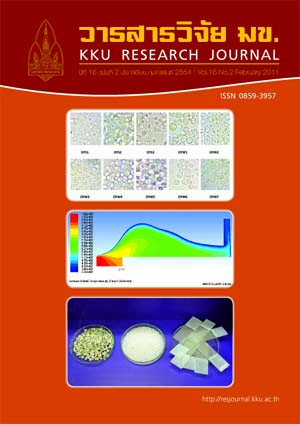Isolation and cultivation of oleaginous yeast for microbial oil production
Main Article Content
Abstract
Yeasts were isolated from oil-contaminated soil and water samples, collected during the rainy season in the area of the KKU campus by the enrichment technique. A total of 69 isolates were obtained, and 10 isolates were preliminarily de ned as oleaginous yeast with lipid accumulation of more than 20% of cellular dry weight (CDW). Among 10 yeast isolates, isolate OYS3 was found to accumulate the highest cellular lipid content. The yeast was identi ed by a molecular genetics technique based on sequence analysis of the variable D1/D2 domain of the large subunit (26S) ribosomal DNA and it was identi ed as Candida viswanathii. The optimal culture conditions for lipid accumulation by C. viswanathii OYS3 were obtained to be as follows: glucose 90 g/L; pH of 5.0; (NH4)2SO4 0.1 g/L, incubated at 30°C. Under these conditions, a biomass of 7.9 g/L, speci c growth rate of 0.258 d-1, and lipid content of 52.7 %CDW could be achieved after cultivation for 8 days. Initial study for ask fed-batch fermentation revealed a biomass of 9.11 g/L and lipid content of 59.50 %CDW. Among the carbon sources tested, pure glycerol supported the maximum biomass of 7.8 g/L with lipid content of 37.2 % CDW, followed by molasses of 7.1 g/L with lipid content of 39.4 %CDW. Gas chromatography analysis revealed that lipids from C. viswanathii OYS3 contained mainly long-chain fatty acids with 16 and 18 carbon atoms. The three major constituent fatty acids were palmitic acid, stearic acid, and oleic acid that are comparable to conventional vegetable oils, suggesting that microbial lipids from the C. viswanathii OYS3 could be used as potential feedstock for biodiesel production.


